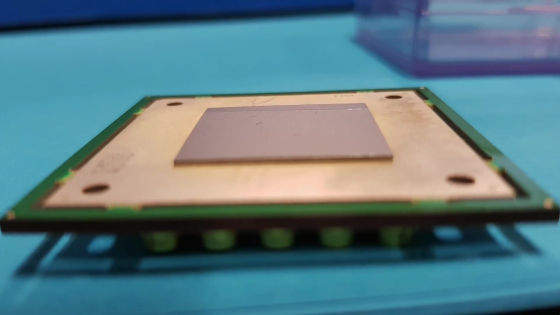Intel manufactures a prototype of a 17-qubit superconducting chip for quantum computers

Intel has 17QubitSucceeded in manufacturing trial chip of superconducting chip "17-qubit superconducting chip" with Qubit (Qubit). A test using a 17-qubit superconducting chip has already been underway to build a quantum computer system.
Intel Delivers 17-Qubit Superconducting Chip with Advanced Packaging to QuTech | Intel Newsroom
https://newsroom.intel.com/news/intel-delivers-17-qubit-superconducting-chip-advanced-packaging-qutech/
Quantum Computer Research Institute of Intel and the NetherlandsQuTechQuantum computer superconducting chip with 17 qubit developed jointly by, can be confirmed with the following movie.
Unboxing the Intel 17-qubit superconducting chip with Leo DiCarlo (QuTech) and Dave Michalak (Intel) - YouTube
The newly developed superconducting chip for quantum computers will be shown by Dave Mikarak of Intel and LeTo Dicarlo of QuTech. Intel and QuTech have collaboratively developed quantum computers since 2015. For both companies steadily developing from simulation of Qubit functioning with quantum computer to real chip development, 17-qubit superconducting chip is one milestone in quantum computer development.

It seems that there is hardiness in the box in which the Intel logo is drawn, and we take it out immediately.

This is "17-qubit superconducting chip", they both smile full of faces.

The 17-qubit superconducting chip has 17 qubits built into the large core.

A number of gold-plated connectors on the back. It is said that there is a connection between the quantum computer and the outside world.

It seems that it is designed to withstand the extremely cold environment in which the quantum computer operates, and Mr. Dicarro says, "This packaging was realized with the technology unique to Intel".

After that, I checked all of the 17 qubits to perform the performance test of the quantum computer. The movie is finished where two people speak, "Come on now."

Quantum computers, also called the ultimate system of parallel computing, may be able to perform processing that is impossible with conventional computers, for example new catalysts for immobilizing carbon dioxide, cold superconductors, new drugs etc. It is expected to enable simulation of molecular modeling to create.
However, superconducting qubits are required to operate at 20 mil Kelvin, which is 250 times as cold as the universe, it is extremely difficult to construct uniformly and stably at a practical level, and it is extremely difficult to develop quantum computing It has become a bottleneck.
The "17-qubit superconducting chip" jointly developed by Intel and QuTech has been improved in terms of reliability, low-temperature environmental performance, reduction of RF noise occurring between qubits, and the like, compared to a chip connected by a circuit It is possible to input and output signals from 1 to 100 times. We succeeded in fitting it to the size of a 50 cent coin equivalent to the conventional silicon semiconductor chip.

QuTech is already using a superconducting chip "17-qubit superconducting chip" to test error control schemes and control to connect multiple qubits to build logical qubits. We are ready to consistently build the whole quantum computing system, not only the applications necessary for quantum computing, but also the hardware and software architecture for controlling it. Furthermore, Intel's ultimate goal isGoogleAs well as 49Qubit processor manufacturing.
Related Posts:







